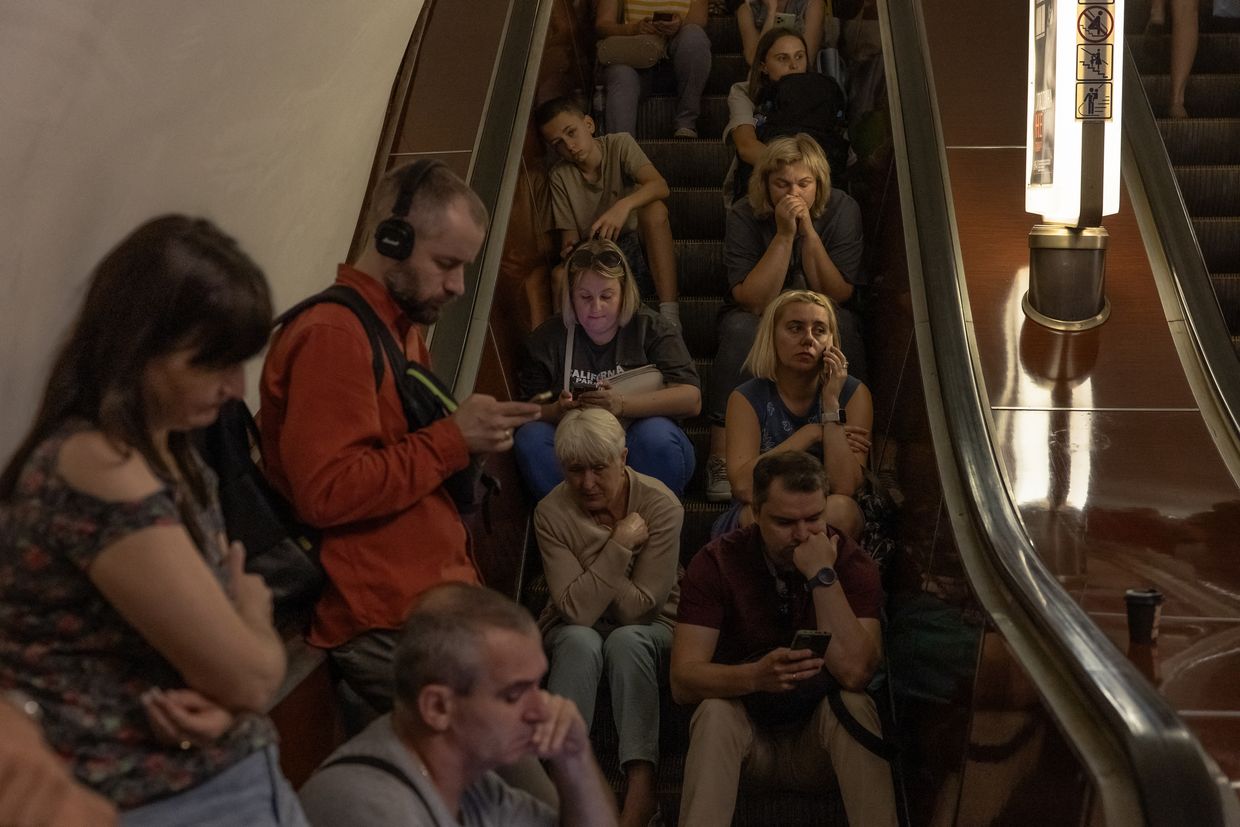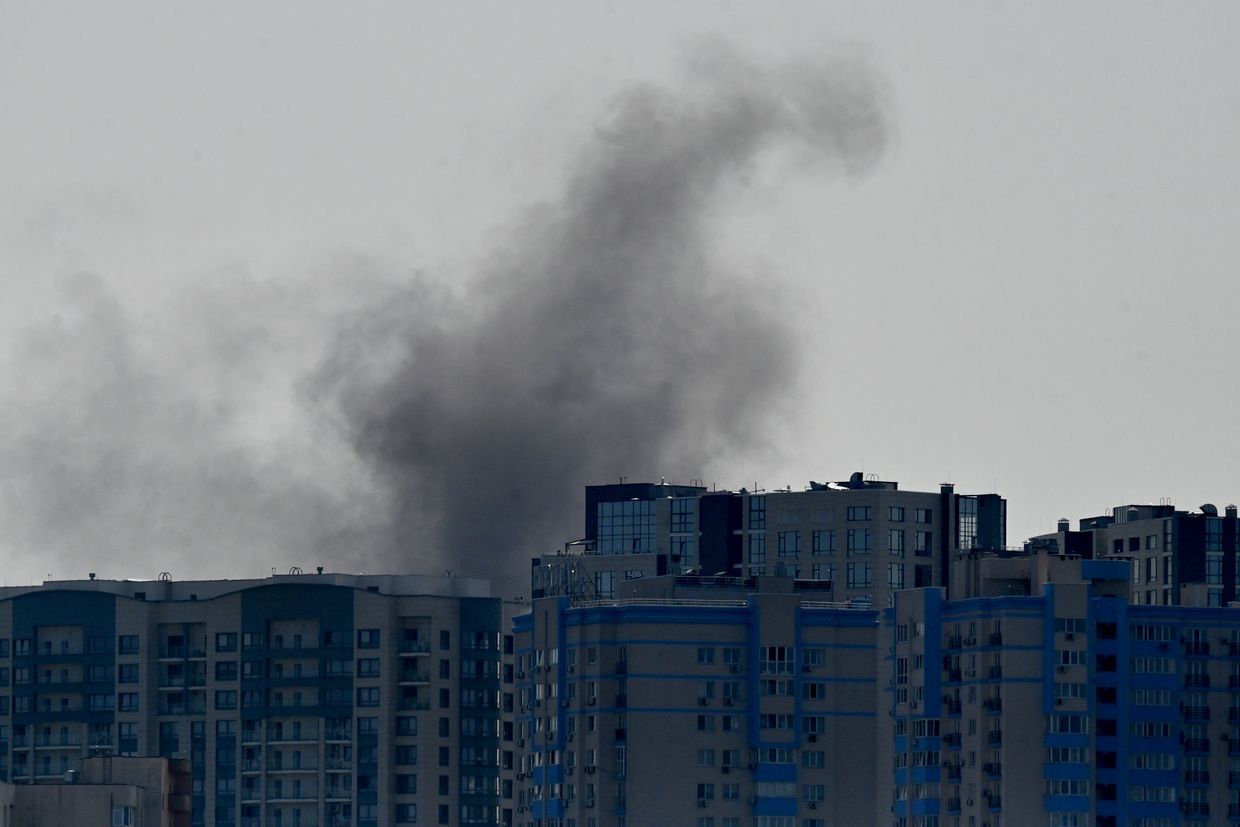Viktoriia Skyba, a 29-year-old mother of two, didn’t have the time to reach a bomb shelter when Russia attacked her town during what Ukrainian officials have said is the largest attack on Ukraine since the full-scale invasion.
She saw a missile flying above her house and a large pillar of smoke rising in the sky following the explosions on Aug. 26 near Kyiv in the town of Vyshhorod, where the Kyiv Hydroelectric Power Plant is located.
“It was such a near-death feeling that cannot be conveyed in words,” Skyba told the Kyiv Independent, adding that her children were “terrified,” too.
Shortly after that, an advisor to the presidential office said that the plant was hit in the morning attack, which targeted critical infrastructure facilities across Ukraine, causing civilian casualties and large-scale power outages in the country.
Ukraine has been racing to restore a severely damaged energy system that has come under waves of Russian attacks since March. It has continued to implement regular scheduled blackouts to reduce demand on its energy infrastructure. This latest attack took place after the energy situation had somewhat improved and scheduled blackouts introduced earlier in the summer were mostly lifted.
Ukraine’s Foreign Minister, Dmytro Kuleba, said 15 of the country’s 24 oblasts had been targeted during the attack “primarily targeting critical civilian infrastructure and our energy system.” Seven people were killed and 47 were injured, according to the State Emergency Service.
Prime Minister Denys Shmyhal said that infrastructure was damaged “in a number of regions,” and emergency power cuts had been introduced to stabilize the system.
A total of 236 aerial targets were recorded by Ukraine’s military. Ukrainian forces shot down 102 missiles and 99 drones, Air Force Commander Mykola Oleshchuk said.
When Skyba heard that the plant was hit, she immediately thought flooding had started on the east bank of the Dnipro River. Skyba said she felt horrified by the thought that she would not be able to visit her parents in Sumy, a city in northeastern Ukraine, anymore.
“What to expect next is unknown… I’m grateful to our Armed Forces, our defenders. They are the only hope that something can change in our country,” Skyba added.
Ruslan Kravchenko, the head of the Kyiv Oblast Military Administration, reported on national television that the attack had not caused the plant any “critical damage.” No significant damage to the plant could be observed from a residential neighborhood located on a hill above the dam as well as from the bridge across it.
New emergency blackouts
The bridge was closed for drivers and pedestrians from the time of the attack until around 6:15 p.m. local time, forcing residents of neighborhoods and villages across the river to wait for hours to get home. One of them was Vasyl Cherniavskyi, a 52-year-old man who works in Vyshhorod.
Cherniavskyi told the Kyiv Independent that he heard the first explosions at his workplace and ran to the nearest bomb shelter when another, even louder explosion rang out. He said it felt like “the ground was shaking” under his feet. “We realized that it hit somewhere near us.”
When asked if he fears that another potential attack would destroy the dam, Cherniavskyi, a father of three, replied, “of course, we are humans, after all.” Despite this fear, Cherniavskyi said, he needs to keep working. “When you are already used to it (the attacks), you don’t think about it. You do everything automatically.”
Energy officials have not yet released their assessments of the damage from Monday’s attack, but residents across the country are feeling the effects.

Shortly after 9:00 a.m., DTEK, Ukraine’s largest private energy company, said emergency power shutdowns were in place across Ukraine. In parts of Kyiv, the energy outages also caused disruptions in the water supply, Kyiv Mayor Vitali Klitschko said. Residents in some regions of Kyiv reported energy outages in place for most of the day and into the night.
The day before the strikes, state energy grid operator Ukrnenergo had said that no outages were scheduled for the following day.
After the strikes, DTEK announced rolling blackouts for the following day in Kyiv, Odesa, Donetsk, and Dnipropetrovsk oblasts to stabilize the grid.
Serhii Kovalenko, chief executive officer at the private energy company Yasno, a subsidiary of DTEK, said that the impact of the attack on the power system is “still being determined.”
According to him, 50-70% of residents in the city of Kyiv and Dnipropetrovsk Oblast will be without electricity on Aug. 27.
‘Not the last such strike’
“We have received all the necessary reports on the energy sector, the current state of the system, and the possibility of restoring it. The work will continue around the clock,” President Volodymyr Zelensky said in his evening address.
“We also thoroughly reviewed the situation regarding protective structures at energy facilities, and several important decisions were made on this matter as well.”
A representative for the Energy Ministry declined to answer questions, citing security reasons, and referred the Kyiv Independent to Zelensky’s public statements.
When reached for comment, a representative for Ukrenergo said, “At this time, the situation after the attack is being assessed. Unfortunately, we cannot provide additional information yet, due to security reasons.”
In a statement, the Russian Defense Ministry said Russia’s military had attacked critical energy infrastructure facilities using high-precision long-range air and sea-based weapons as well as strike drones.

The targets of its strike were electric substations in Kyiv, Vinnytsia, Zhytomyr, Khmelnytskyi, Dnipropetrovsk, Poltava, Mykolaiv, Kirovohrad, and Odesa oblasts, the statement said. While the Russian Defense Ministry claimed all designated targets were hit and that it had also damaged gas compression stations in Lviv, Ivano-Frankivsk, and Kharkiv regions, Ukraine’s Air Force said it had shot down over 200 over the 236 missiles and drones launched by Russia at the country.
The Kyiv Independent was not able to confirm the accuracy of either statement.
The strike is further proof that Russia has not wavered from its plans to destroy Ukraine’s energy system, said Roman Nitsovych, research director for the Ukrainian energy think tank DiXi Group.
“I don’t think it’s the last such strike on energy infrastructure,” he added.
The attacks on Monday once again reinforced the need for Ukraine to build more power generation and for allies to supply additional air defenses, Nitsovych said.
“If we allow the power system to be destroyed, then the Western governments will face another wave of migration, especially in the wintertime, a very fragile period,” said Nitsovych. “Already, we understand that we need to reassess the status of the power system and the way it will operate in the wintertime.”
Ukraine preparing to respond to Russian mass attack with homemade weapons, Kyiv says
Shortly before, President Volodymyr Zelensky revealed that Ukraine has developed a domestic-made missile-drone, Palianytsia.


